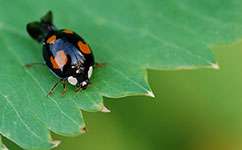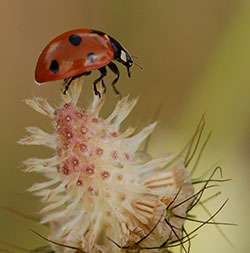(Phys.org) —The extraordinary heights and speeds of ladybird flight paths have been revealed for the first time.
Scientists examining radar data have spotted the tiny creatures travelling at heights of up to 1100 metres, and at speeds of up to 60 kilometres per hour.
The discovery, published in the journal PLOS ONE, means that, in theory, ladybirds could travel from London to Birmingham in little more than two hours.
It could explain why invasive insects such as the harlequin ladybird have managed to spread so quickly from one part of the country to another.
The study also suggests that ladybirds are able to travel further when temperatures are warmer, a phenomenon that could exacerbate the problems posed by invaders as the climate warms.
Dr Lori Lawson Handley, from the University of Hull, led the research.
'These are the first recordings of ladybirds travelling at such extraordinarily high altitudes,' she says.
'Ladybirds are very capable flyers on their own, but this puts them up in the stronger winds where they can travel faster and further.'
The team worked out what a ladybird would look like to a radar scanner through tests in the laboratory. They then poured back through radar data collected throughout the past ten years above the Rothamsted research centre in Hertfordshire, UK.
7 spot ladybird, Coccinella septempunctata.
'If you imagine a ladybird's shape, it's actually quite characteristic,' says Lawson Handley.
'They're more spherical compared to other insects, so between their weight, width and height, we can be pretty confident that we're identifying ladybirds in the radar data.'
Most of the ladybirds were found at heights between 150 and 500 metres above the ground, flying at an average speed of 30 kilometres an hour. But some were found at even higher altitudes, travelling even faster.
In separate experiments, the team recorded the flight times of ladybirds in a Perspex box. The average flight lasted 36.5 minutes, with some going on for as long as 2 hours.
This would mean that ladybirds could travel up to 120 kilometres in a single flight. Until now, anything over two metres was classed as long-distance flying. But Lawson Handley cautions that these flight times are yet to be tested in a real-world setting.
Ladybirds are the most important predator of aphids, a common insect pest threatening food crops all over the world. As such, non-native species of ladybird are often introduced onto farmland as a biological control measure.
From there, they can quickly spread, often outcompeting native species, like the struggling British two-spot, and inflicting damage on local ecosystems.
In an effort to tackle the problem, flightless harlequins were successfully bred and deployed on farms in continental Europe. But they have since mated with flying ladybirds, allowing their spread to continue unabated.
Until now, it has been difficult to understand just how far they are capable of dispersing on their own because they are often accidentally carried by humans.
A recent citizen science project, calling on members of the public to send in photos and locations of ladybird sightings, has helped scientists to build a picture of the spread of the invasive harlequin.
The results suggest that the harlequins' progress has slowed as they have encountered the obstacles of the Pennine and Cambrian mountain ranges. Lawson Handley believes that temperature may hold the key.
'Our study has shown that temperature was even more important for triggering the dispersal of ladybirds than scarcity of their primary food source,' she explains. 'So it may be that the colder temperatures above the mountains are proving a difficult barrier to overcome.'
This question will now form the main focus of the team's research, which they hope to report on in the coming months.
More information: Daniel Jeffries, Jason Chapman, Helen Roy, Stuart Humphries, Richard Harrington, Peter Brown, Lori Lawson Handley, "Characteristics and Drivers of High-Altitude Ladybird Flight: Insights from Vertical-Looking Entomological Radar", 2013, PLOS ONE.
Journal information: PLoS ONE
Provided by PlanetEarth Online
This story is republished courtesy of Planet Earth online, a free, companion website to the award-winning magazine Planet Earth published and funded by the Natural Environment Research Council (NERC).

























